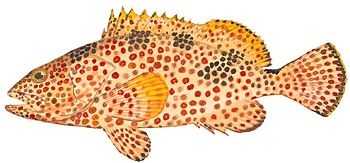Rock Hind

Species Details
Epinephelus Adscensionis
Serranidae
Perciformes
Reefs, inshore, offshore
9 - 10 lbs.
23" - 26"
Rock Hind (Epinephelus adscensionis) Fish Description
The Rock Hind fish, also known under many names such as the Butterfish, Deady, Grasby, Cod, Hind, Rock Grouper, Rock Cod, and Trout.
Rock Hinds can vary in color, such as the other types of grouper fish, but they’re most often red-brown spotted all over their bodies, fins, and tails and pale tan to olive-brown color.
Observers can distinguish the Rock Hind from the Red Hind, as they are similar in appearance, through the Rock Hinds behavior. As they have a tendency to be more reclusive and shying away from human interaction. And that the Rock Hind has 1 to 4 pale or dark splotches appearing on its back, and that its tail and anal fins have broad white outlines, and lack thereof black margins that a Red Hind would have. And that the Rock Hind fish can change, turning pale or darken rather dramatically.
Diet & Size
Rock hind fish diet predominantly consists of crabs and fishes. Rock hind can grow up to 2 ft. in length, and weigh about 8 to 9 lbs.
Interesting Facts about Rock Hind
- Rock Hinds can live up to the age of 50 years old.
- Rock Hinds, ultimately as grouper fish often are, are carnivores. They often hunt near the bottom of the sea, frequently at dusk. How they consume their prey is by opening their large mouths and using it as a powerful suction to swallow their prey whole.
- Rock Hinds are considered to be hermaphrodites, which means they can change their sex.
- Rock hind cluster together during spawning along offshore rocky reefs, from January to June.
- Low-frequency sounds seem to emanate from these Rock Hinds, by produce vibrations from their axial muscles against their swim bladders. This documented sound is likely associated with the user in regards to courtship and spawning.
Fishing Techniques
If you’re an angler looking to catch a Rock Hind, it’s ideal to choose one of the coldest months of the year to fish, around September to March. And to look for areas, such as breakwaters near ports, as they use these areas to hide. The best groupers you’ll catch, such as the Rock HInd, would be by using a boat, as you go forward to deeper waters as adult Rock Hind commonly inhabit therein. The usual methods for catching Rock Hind would be hook and line and netting, and even spearfishing, but due to the Rock Hind being a protected species it’s no longer much of an option. You can also use trolling as a method for catching Rock Hind, especially if you’re in a large group.
Bottom-line fishing is best for attempting to catch a grouper such as Rock Hind in deeper waters, or maybe around 400m. Remember to use a very hard line, and your best bet for bait could be a live fish, squid, chub mackerel, sardine, white crab, or, even their favorite, a piece of an octopus to tempt it, skewered onto a solid hook resistant to their big jaws. If you’re lucky to feel it bite, best prepare for one of the best fights between you and the Rock Hind.
Often, Rock Hinds are notorious for entangling an angler’s line into some rocks, so when you feel that bite, but also feel that your line has gotten caught in something, stop pulling. It most probably means that the fish had gone back to their home and they won't stop pulling at your line until they feel secure. What you can do to take advantage of the predicament is when it drops, it's to pull again and tire out the fish before you can bring it in. Please note that if it's a huge catch of a fish, try not to grab them from their gill covers because they are jagged sharp and groupers tend to have a tremendous amount of strength.
Habitat and Distribution
Rock Hind fish are solitary creatures who inhabit areas near jetties, rocky inshore regions in shallow waters, or deep reefs as well. They can be frequently found drifting near the bottom of the ocean.
They range from Massachusetts to southeastern Brazil, like in Bermuda, Bahamas, Eastern Caribbean, and the northern Gulf of Mexico in the western Atlantic. They are a rare sight north of Florida.







